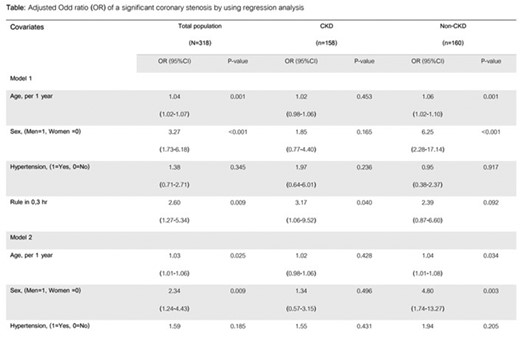-
PDF
- Split View
-
Views
-
Cite
Cite
P Kotruchin, T Tangpaisarn, N Srimakam, P Phungoen, V Senthong, Differential association between significant coronary stenosis and cardiac troponin T serial algorithms in renal dysfunction patients diagnosed with non-ST-segment elevation acute coronary syndromes, European Heart Journal, Volume 43, Issue Supplement_1, February 2022, ehab849.072, https://doi.org/10.1093/eurheartj/ehab849.072
Close - Share Icon Share
Abstract
Type of funding sources: Public Institution(s). Main funding source(s): Faculty of Medicine Khon Kaen University
High-sensitivity cardiac troponin T (hs-cTnT) is recommended for diagnosing non-ST segment elevation acute coronary syndromes (NSTE-ACS). While the standard practice guidelines recommend using the 0,1-hour (hr) and 0,3-hr hs-cTnT algorithms, their efficacy has been not clearly established in chronic kidney disease (CKD) patients.
We aimed to assess the differential associations between the two algorithms mentioned above with significant coronary stenosis in CKD patients.
This was a retrospective cohort study. Patients aged ≥18 years (yr) who were diagnosed with NSTE-ACS and had undergone coronary angiogram were recruited. The differential association between significant coronary stenosis and being ruled in based on the 0,1-hr and 0,3-hr hs-cTnT algorithm in both CKD patients and those normal renal function was analyzed and reported.
There were 158 and 160 patients in the CKD group and the normal renal function group, respectively. The prevalence of significant coronary stenosis was higher in the CKD group (70.4% vs. 57.8%, P =0.028). Among CKD patients, factors associated with significant coronary stenosis were hypertension (OR =2.68; 95%CI 1.10-6.50) and being ruled in by the 0,3-hr algorithm (OR =3.65; 95%CI 1.27-10.52). In the normal renal function group, age (OR =1.04; 95%CI 1.01-1.06), male sex (OR =2.15; 95%CI 1.09-4.22), and being ruled in by the 0,1-hr algorithm (OR =3.12; 95%CI 1.20-8.10) were associated with significant coronary stenosis.

Abstract Figure. Adjusted OR of a coronary stenosis



